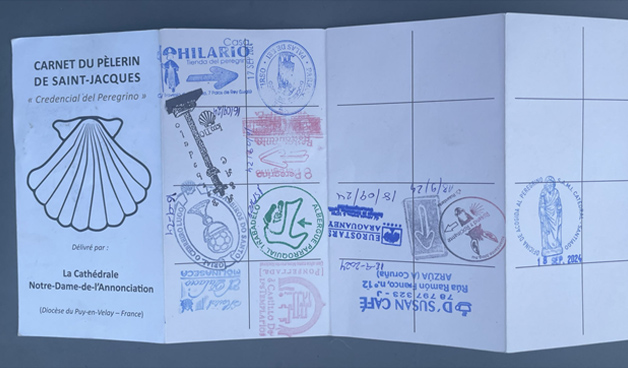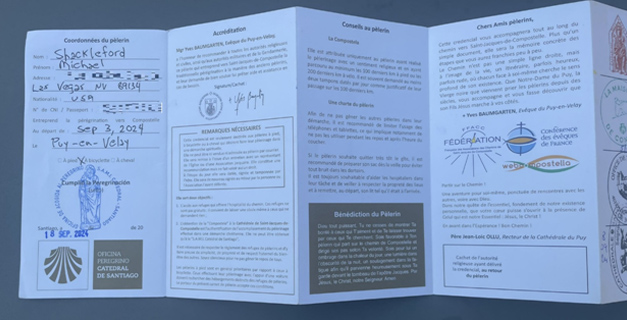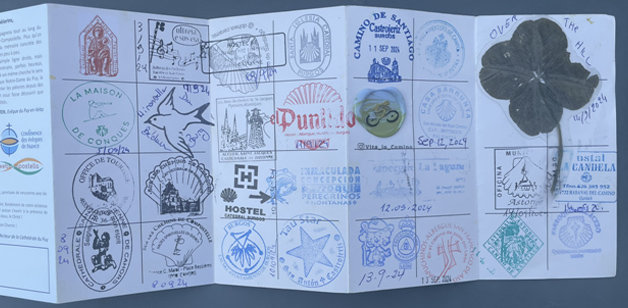Camino de Santiago – Part 16
In the previous section, part 15, I found myself in the plaza in front of the stunning Santiago Cathedral on September 18, 2024. While seated there, I was lost in thought, trying to make sense of how to spend the rest of that day, my ongoing journey, and even my future.
After sitting in silence for a while without any insights, I struck up a conversation with a fellow traveler. She had just arrived the day before and was patiently waiting for her friend. I inquired about the whereabouts of the Pilgrim Office, and she kindly provided the information I needed. This is where pilgrims can present their credentials—the documents in which they collect stamps—to obtain two completion certificates, one in Spanish and another in Latin.
I proceeded to the Pilgrim Office, which was a short five-minute stroll from the Cathedral. A memorable scene from the film 'The Way' takes place in that very location, where the main characters are questioned about their motivations for undertaking the Camino. The number of individuals pursuing the Camino increases by approximately 10% annually, so I figured the office might have had more means to personally interview each person during the film's time. However, I embarked on the Camino years later during peak season when hundreds of pilgrims arrived daily, and I had heard the application process was now more streamlined.
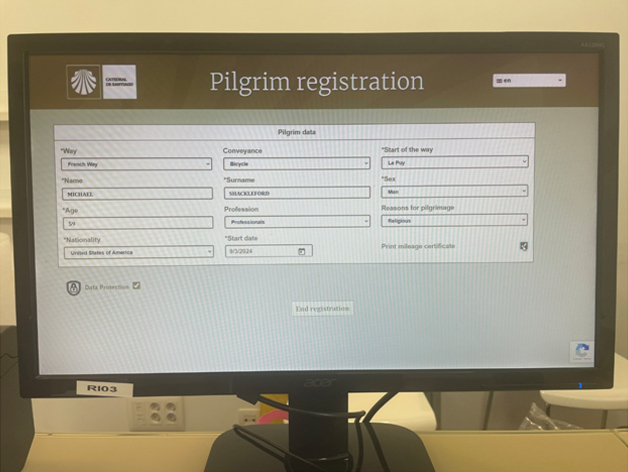
From watching the film, I anticipated that one of the questions would inquire whether I was undertaking the Camino for spiritual reasons. In my pre-trip research, I came across images of the two types of certificates. Those awarded for 'religious reasons' were more elaborate and meaningful, while the alternative was more straightforward. Currently, I don't practice any religion, although I am an ordained minister in the Church of the Flying Spaghetti Monster, which is, of course, a parody religion. Nonetheless, if one takes a broad view of the term 'religious,' I felt confident answering 'yes' without hesitation.
The second dilemma revolved around my starting point. As previously mentioned, I initiated my journey in Le Puy-en-Velay, France, but skipped a significant section from Cahors, France, to Burgos, Spain. One of the requirements states that the credential must be 'duly stamped from each stage of the route.' Clearly, I lacked stamps for the section I bypassed.
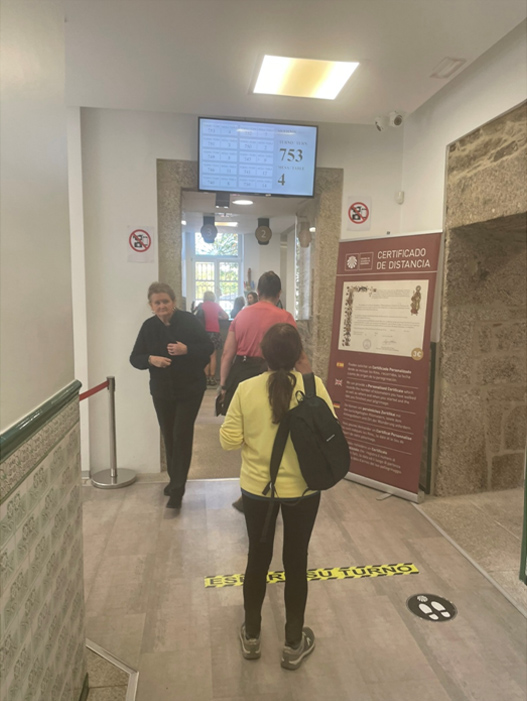
I strongly believed that my journey had begun in Le Puy, and I was eager for my certificate to reflect that. I faced numerous challenges on the French portion and felt it warranted acknowledgement on my certificate. Additionally, I had gathered ample stamps from each segment of MY specific route. If the officials at the pilgrim's office called attention to my lack of stamps, I intended to be completely honest about it and, if necessary, accept a certificate starting from Burgos.
With this strategy in mind, I walked into a bustling Pilgrim Office. A staff member directed me to a side room filled with check-in kiosks reminiscent of airport check-in counters. The screens prompted me to enter basic details like my name, dates of departure and arrival, and the two questions I had prepared for. I answered honestly as initially planned. Afterward, I was issued a number similar to those given at the DMV and awaited my turn to be called.
The wait lasted about 15 minutes, much shorter than I had anticipated, given the crowd. When my turn came, the attendant requested my credential, which I promptly provided. She spent a minute or so quietly examining it, and I felt anxious that she might question me regarding the missing stamps or probe into my religious affiliation. Nevertheless, she remained silent, took her own stamp, and marked my credential, presumably to formalize it. Soon after, I saw her printing my certificates in color, which she handed over to me while saying, 'congratulations.'
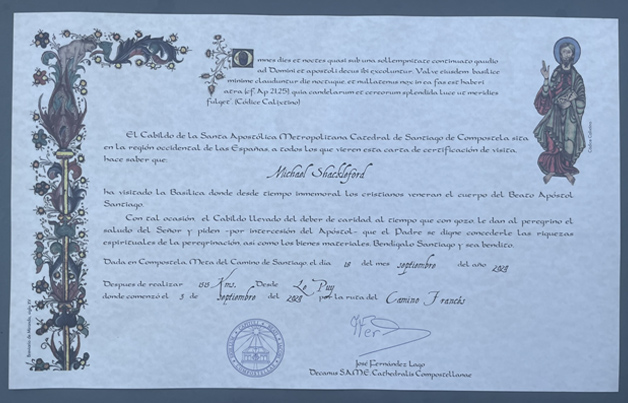
The opening paragraph is in Latin, and here is how it translates using Google Translate.
"All days and nights are celebrated there, as if under one solemnity, with continuous joy, to the glory of the Lord and the apostles. The doors of the same basilica are never closed day or night, and it is not permissible to have night in it at all, because the light of candles and tapers shines as if it were noonday.\"
The remainder of the text is in Spanish, and I translated it to English, which proved to be quite challenging.
"The counsel of the Holy Apostolic Metropolitan Cathedral of James of Compostela in the western part of Spain, to all who receive this certificate of visit, should know that:
Michel Shackleford
Visited has the Cathedral where, since ancient times, Christians have honored the remains of the blessed Apostle James.
On this occasion, the Counsel extends the duty of charity along with joy, offering the pilgrim a greeting from God and requesting the Apostle's intercession—that the Father may grant not only the material goods but also the spiritual enrichment that comes from the journey. Blessed be James and blessed be all.
Issued in Compostela, the destination of the Camino, on the 18th day of September in 2024.
After completing 1515 kilometers starting from Le Puy on the 5th of September 2024 via the French Way route.\"
I felt an immense sense of relief and happiness upon receiving my certificate. In the gift shop, I bought a tube to safeguard my certificates as well as a beautiful map depicting the French Way section of the Camino. Adjacent to the shop was a lovely patio overlooking a courtyard where other pilgrims were taking photographs, and one was kind enough to take a few for me.
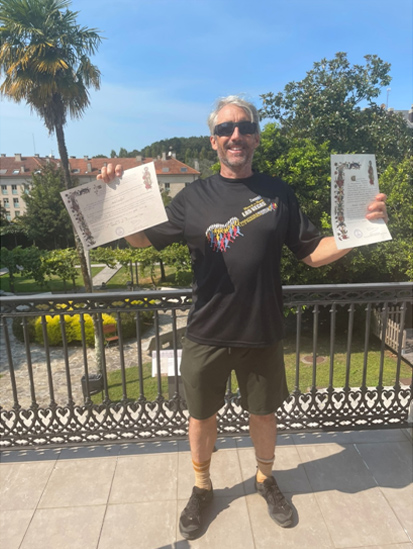
Afterward, I headed to my hotel, which I had reserved the day prior at the Albergue in Arzúa. Locating it had proven a bit of a challenge. Online travel platforms indicated that only one hotel room was available in the entire city, specifically at the Araguaney. This hotel was quite upscale, part of the luxurious Eurostars Hotel chain. I felt somewhat embarrassed to step into such a fancy place, resembling a weary traveler. However, the staff treated me exceptionally well, completely unbothered by my disheveled appearance. Despite it being nearly noon, they graciously allowed me to check in early and directed me to a secure place to store my bicycle in a garage room.
My room was absolutely stunning, a stark contrast to the hostels and budget hotels I had stayed at previously throughout my journey. I felt a bit out of place in such luxury. After spreading my belongings throughout the room, I took a refreshing shower and changed into clean clothes.
One of my primary goals for the day was to arrange for my bicycle's return home. Many fellow travelers and some locals along the Camino mentioned that there was a post office near the cathedral where they handled bike shipping for pilgrims daily. Indeed, I discovered a post office with plenty of boxes for bicycles and a dedicated counter for that service. Unfortunately, the clerk informed me they didn’t ship to the United States.
This presented a significant challenge. A quick online search revealed that private companies could ship bikes, but their fees were around 1,000 Euros, which was approximately equivalent to my bike's current worth. Adding customs fees would likely make it even more expensive. I found myself grappling with the dilemma of how to return my bike—whether to ship it, sell it, or give it away. The details of that will unfold in the next chapter of my journey.
The remainder of the afternoon was spent enjoying food and drinks while exploring the town. I participated in the 'free tour' offered in Santiago, and having previously taken similar tours in cities like Mexico City and Barcelona, I can highly recommend them. Just remember to tip based on your assessment of the tour's quality.
That evening, I aimed to attend the Pilgrim’s Mass, but to my disappointment, the cathedral was already at capacity when I arrived shortly before the service began. Fortunately, I still had two whole days left before my flight home.
In the next chapter, I will share the experiences I had during those final two days of my adventure.
